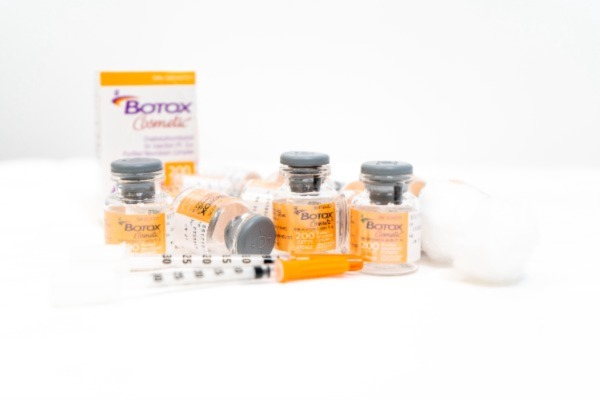If you suffer from chronic pain or headaches, you may have considered Botox as a possible treatment option. But what does the current research say about Botox and headache treatment? Let’s take a look.
What is Botox (Botulinum Toxin Type A)?

Botox is a purified and dilute neurotoxin produced by the Clostridium botulinum bacterium. Botox works by blocking nerve signals and paralyzing muscles. This muscle paralysis is temporary, lasting for 3 – 4 months.
When used for headache treatment, Botox is injected into specific muscles in the head and neck region. The most common injection sites are the forehead, temples, and back of the head.
Botox injections in specific sites under the skin around your face and neck can decrease brain chemicals that cause migraine pain, such as calcitonin gene-related peptides. Over time this treatment may help dull down reactions to triggers so you feel less severe headaches or nausea during an attack.
Who Should Administer Botox Injections?
Botox injections should only be administered by a trained healthcare professional. Injections should be given in very specific areas in order to minimize the risk of side effects.
Overall, Botox is considered a safe treatment with minimal side effects when administered by a trained healthcare professional. The most common side effect is temporary bruising or soreness at the injection site. Other potential side effects include drooping eyelids, dry eyes, and headaches. These side effects are usually mild and resolve on their own within a few days.
Current research and evidence for the use of Botox in the treatment of headaches

Several studies have shown that Botox is an effective treatment for chronic headaches and can significantly reduce pain levels. In one study, 78% of participants reported a reduction in headaches after receiving botox injections.
Another study found that botox can help to prevent migraines, with participants reporting a 50% reduction in migraine days after treatment.
A recent systematic review, published in 2022 in Pain Research and Management, found that Botox was a low-cost option for the treatment of various kinds of migraines, including chronic, episodic, unilateral, and vestibular types. Botox can reduce the frequency of migraine attacks per month and diminish the severity of pain.
A Cochrane review published in 2018, concluded that in chronic migraine, botulinum toxin reduces migraine frequency by 2 days/month and has a favourable safety profile.
The FORWARD study, published in 2019 in Headache, compare Botox to Topiramate for headache prevention in adults with chronic migraine. The study found Botox to have greater clinical utility than Topiramate, mostly because it was tolerated better and a higher number of Botox patients remained on treament.
Who might be a good candidate for Botox treatment for chronic headaches?
The best candidates for Botox treatment are those who have tried other treatments without success. Botox is also a good option for those who cannot take medication or who are unable to tolerate the side effects of medication.
Conclusion
If you are considering Botox for the treatment of your chronic headaches, there is good evidence to support its use. However, it is important that you consult with a physician experienced in managing patients with chronic headaches to ensure that the injections are administered properly.
Disclosure: The information in this article is not intended to replace your doctor’s medical advice, diagnosis or treatment. If you require more information, or have any questions, please speak to your doctor/ specialist.
References:
- Cochrane systematic review and meta-analysis of botulinum toxin for the prevention of migraine. Clare P Herd, Claire L Tomlinson, Caroline Rick, William J Scotton, Julie Edwards, Natalie J Ives, Carl E Clarke, AJ Sinclair. http://dx.doi.org/10.1136/bmjopen-2018-027953.
- Shaterian N, Shaterian N, Ghanaatpisheh A, Abbasi F, Daniali S, Jahromi MJ, Sanie MS, Abdoli A. Botox (OnabotulinumtoxinA) for Treatment of Migraine Symptoms: A Systematic Review. Pain Res Manag. 2022 Mar 31;2022:3284446. doi: 10.1155/2022/3284446. PMID: 35401888; PMCID: PMC8989603.
- Rothrock JF, Adams AM, Lipton RB, Silberstein SD, Jo E, Zhao X, Blumenfeld AM; FORWARD Study investigative group. FORWARD Study: Evaluating the Comparative Effectiveness of OnabotulinumtoxinA and Topiramate for Headache Prevention in Adults With Chronic Migraine. Headache. 2019 Nov;59(10):1700-1713. doi: 10.1111/head.13653. Epub 2019 Sep 26. PMID: 31559634; PMCID: PMC6899480.

Dr. Ilonka Meyer is the Clinical Director and Founder of MindBodyPainSpecialists. She also holds an appointment as Acting Director of the Pain Service and Pain Specialist at the Austin Hospital in Heidelberg, Melbourne. Ilonka has a strong interest in interventional pain treatments, peri-operative pain and medication optimisation and cancer pain.
Ilonka is skilled in Clinical Research, Medical Education, Coaching, and Healthcare Management. Her main research focus lies in interventional pain medicine in the peri-operative population, cancer pain and the health economic benefits of pain and medication optimisation in patients both pre-and postoperatively.
